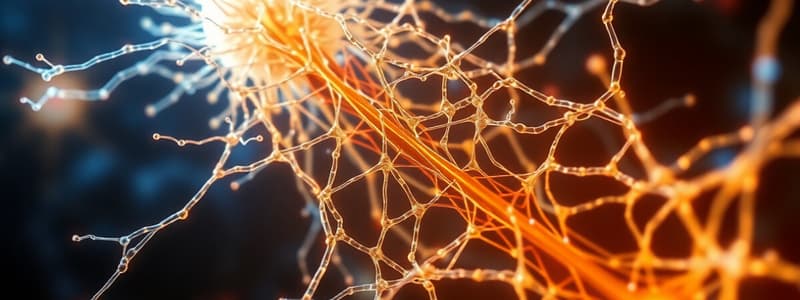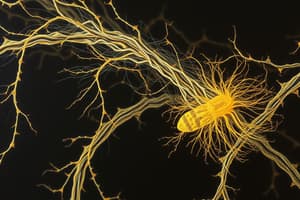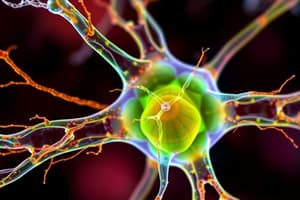Podcast
Questions and Answers
What role do organelles play in cellular function?
What role do organelles play in cellular function?
Organelles compartmentalize incompatible functions, increase lipid surface area for membrane-related activities, and concentrate molecules in a confined space.
Define the endomembrane system and its main functions.
Define the endomembrane system and its main functions.
The endomembrane system is a group of organelles involved in protein production, quality control, and secretion; it also internalizes substances from outside the cell.
What is the process called that brings molecules into a cell?
What is the process called that brings molecules into a cell?
Endocytosis.
What mechanism is used to move molecules out of a cell?
What mechanism is used to move molecules out of a cell?
Signup and view all the answers
Identify the three mechanisms by which proteins are sorted within a cell.
Identify the three mechanisms by which proteins are sorted within a cell.
Signup and view all the answers
Which protein sorting method requires that proteins remain unfolded?
Which protein sorting method requires that proteins remain unfolded?
Signup and view all the answers
What determines a protein's destination within a cell, and how was this discovered?
What determines a protein's destination within a cell, and how was this discovered?
Signup and view all the answers
Describe the nuclear pore, its structure, and its function.
Describe the nuclear pore, its structure, and its function.
Signup and view all the answers
What are the three types of cytoskeleton components, and what is their main function?
What are the three types of cytoskeleton components, and what is their main function?
Signup and view all the answers
Describe the structural assembly of intermediate filaments.
Describe the structural assembly of intermediate filaments.
Signup and view all the answers
How do intermediate filaments structurally differ from actin filaments and microtubules?
How do intermediate filaments structurally differ from actin filaments and microtubules?
Signup and view all the answers
What is the primary role of nuclear lamins?
What is the primary role of nuclear lamins?
Signup and view all the answers
Describe the structure and function of microtubules.
Describe the structure and function of microtubules.
Signup and view all the answers
What defines the plus end of the microtubule?
What defines the plus end of the microtubule?
Signup and view all the answers
What is an MTOC and its function?
What is an MTOC and its function?
Signup and view all the answers
Name one protein found in intermediate filaments.
Name one protein found in intermediate filaments.
Signup and view all the answers
What is the role of specialized proteins in nuclear import?
What is the role of specialized proteins in nuclear import?
Signup and view all the answers
How do import receptors facilitate the nuclear import process?
How do import receptors facilitate the nuclear import process?
Signup and view all the answers
What triggers the directionality of nuclear import/export?
What triggers the directionality of nuclear import/export?
Signup and view all the answers
Which form of RAN is found in high concentration in the nucleus, and why?
Which form of RAN is found in high concentration in the nucleus, and why?
Signup and view all the answers
Why is Ran-GDP predominant in the cytoplasm?
Why is Ran-GDP predominant in the cytoplasm?
Signup and view all the answers
What is the purpose of immunoprecipitation in protein studies?
What is the purpose of immunoprecipitation in protein studies?
Signup and view all the answers
What does it indicate when two proteins immunoprecipitate together?
What does it indicate when two proteins immunoprecipitate together?
Signup and view all the answers
What steps does a protein take to be secreted from the cell?
What steps does a protein take to be secreted from the cell?
Signup and view all the answers
What is the process by which a cell engulfs something to become part of itself?
What is the process by which a cell engulfs something to become part of itself?
Signup and view all the answers
How do early endosomes differ from late endosomes in function?
How do early endosomes differ from late endosomes in function?
Signup and view all the answers
What role do lysosomes play in cellular digestion?
What role do lysosomes play in cellular digestion?
Signup and view all the answers
Describe the pathway of an internalized molecule after it enters the cell.
Describe the pathway of an internalized molecule after it enters the cell.
Signup and view all the answers
What maintains the low pH of lysosomes?
What maintains the low pH of lysosomes?
Signup and view all the answers
What is receptor recycling in the context of cell membranes?
What is receptor recycling in the context of cell membranes?
Signup and view all the answers
How do lysosomal proteins, such as degradative enzymes, reach lysosomes without degrading there?
How do lysosomal proteins, such as degradative enzymes, reach lysosomes without degrading there?
Signup and view all the answers
What distinguishes pinocytosis from phagocytosis?
What distinguishes pinocytosis from phagocytosis?
Signup and view all the answers
Why do enzymes not degrade in the lysosome?
Why do enzymes not degrade in the lysosome?
Signup and view all the answers
What is the primary symptom of Familial Hypercholesterolemia (FH) patients?
What is the primary symptom of Familial Hypercholesterolemia (FH) patients?
Signup and view all the answers
What happens to cholesterol biosynthesis in normal cells when LDL is absent?
What happens to cholesterol biosynthesis in normal cells when LDL is absent?
Signup and view all the answers
What occurs to cholesterol biosynthesis in normal cells when LDL is present?
What occurs to cholesterol biosynthesis in normal cells when LDL is present?
Signup and view all the answers
In FH cells, how does the absence of LDL affect cholesterol biosynthesis?
In FH cells, how does the absence of LDL affect cholesterol biosynthesis?
Signup and view all the answers
What is the effect of LDL on cholesterol biosynthesis in FH cells?
What is the effect of LDL on cholesterol biosynthesis in FH cells?
Signup and view all the answers
What did Brown and Goldstein discover regarding cholesterol metabolism in normal individuals?
What did Brown and Goldstein discover regarding cholesterol metabolism in normal individuals?
Signup and view all the answers
What did Brown and Goldstein find about LDL receptors in FH patients?
What did Brown and Goldstein find about LDL receptors in FH patients?
Signup and view all the answers
Why is p53 referred to as a tumor suppressor?
Why is p53 referred to as a tumor suppressor?
Signup and view all the answers
What role does active S-CDK play during the cell cycle?
What role does active S-CDK play during the cell cycle?
Signup and view all the answers
What critical decisions occur during the G2/M checkpoint?
What critical decisions occur during the G2/M checkpoint?
Signup and view all the answers
Describe the primary functions of active M-CDK.
Describe the primary functions of active M-CDK.
Signup and view all the answers
What happens to chromosomes during metaphase and anaphase?
What happens to chromosomes during metaphase and anaphase?
Signup and view all the answers
What is the function of kinetochores in the cell cycle?
What is the function of kinetochores in the cell cycle?
Signup and view all the answers
When is cohesin loaded onto chromosomes, and when is it removed?
When is cohesin loaded onto chromosomes, and when is it removed?
Signup and view all the answers
How does cytokinesis differ between animal and plant cells?
How does cytokinesis differ between animal and plant cells?
Signup and view all the answers
Study Notes
Cytoskeleton Components
- Three types: intermediate filaments, microtubules, and actin filaments
- Intermediate filaments: withstand stress, found in muscle and skin cells
- Microtubules: intracellular transport highways, chromosome segregation, located in centrosomes
- Actin filaments: cortex stabilization, cell movement, muscle contraction; located beneath the plasma membrane
Intermediate Filaments Structure
- Single polypeptide wraps around another to form a dimer
- Dimers attach anti-parallel
- No polarity
- Eight dimers form a tetramer
- Tetramers bind to form a filament
- Network in cytoplasm, surround nucleus, extend to cell junctions (desmosomes)
- Keratin and lamin are examples
Intermediate Filaments vs. Actin and Microtubules
- Intermediate filaments are protein polymers
- Microtubules are dynamic, hollow tubes made of monomers (flexible or stiff)
- Actin filaments are flexible chains of monomers
Nuclear Lamins Function
- DNA replication, RNA transcription
- Nuclear and chromatin organization
- Cell cycle regulation
- Cell development and differentiation
- Nuclear migration
- Apoptosis
Microtubules Structure
- Subunits stack to form a filament
- Attach to other filaments to form a hollow tube
- Plus and minus ends
- Grows at both ends
- Anchored to the nucleus
- Alpha-tubulin and beta-tubulin are protein subunits
Microtubule Organizing Center (MTOC)
- Organizes location, number, and orientation of microtubules
- Near the nucleus
- Orient the same way
Microtubules Dynamic Instability
- Growing and shrinking of microtubules
- Catch molecules
GTP Hydrolysis in Microtubules
- Controls dynamic stability
Actin Treadmilling
- New actin monomers added to plus end faster than minus end
- Monomers come off of minus end
- Treadmilling effect
Actin Modification
- Severing proteins cut filament in half
- Bundling proteins group filaments together
- Cross-linking proteins set filaments across each other
Myosin's Role
- Generates force and movement toward plus end of actin
Cytoskeleton Proteins Comparison
- Intermediate filaments are symmetric backbones connecting cells and tissues
- Microtubules are structural backbones with plus and minus ends used in transport activity
- Actin is a protein polymer used in movement
Motor Proteins (Kinesin and Dynein)
- Kinesin: plus end-directed; functions in synapse
- Dynein: minus end-directed; moves towards the cell body
- ATP hydrolysis powers motor movements
- Cargo binding domain and cytoskeletal binding domain
- Kinesin and dynein position organelles (e.g., in neurons)
Myosin Function
- Binds, releases, rebinds to move along actin filaments
- Moves cargo
Action Potential Muscle Contraction
- Electrical signal travels from neuron to muscle
- Neurotransmitters are released
- Action potential in the muscle cell's plasma membrane
- Calcium released into cytoplasm
- Calcium binding proteins expose myosin binding sites on actin
Calcium's Role in Muscle Contraction
- Exposes binding sites on actin by binding to troponin, removing tropomyosin
- Other muscle contractions requirements are Magnesium, potassium, ATP, acetylcholine, and vitamin D
Endomembrane System
- Organelles compartmentalize incompatible functions, providing more surface area
- High concentration of molecules in a small space
- Includes endoplasmic reticulum (ER), Golgi, and lysosomes, responsible for production, modification, sorting and trafficking of proteins, lipids and other materials.
Endocytosis
- Cellular uptake of molecules from external environment, including phagocytosis, pinocytosis, and receptor-mediated endocytosis processes
Lysosomes
- Spherical structures with hydrolytic enzymes
- Degradation of material taken by endocytosis
- Low pH maintained by proton pumps
Receptor Recycling
- After binding to ligand, receptor is internalized, then returned to membrane
Protein Degradation in Lysosomes
- Enzymes are synthesized in the rough ER and tagged with M6P marker
- Directed to the Golgi and then early endosome becoming a late endosome and finally fusing with lysosome
Receptor-Mediated Endocytosis
- High blood cholesterol (FH). LDL receptor deficiency causing the cell to not be able to suppress cholesterol production, due to lack of LDL cholesterol
- Uptake of LDL cholesterol by LDL receptors
- Cholesterol metabolism regulation by LDL receptors
Cell Cycle
- The series of events a cell goes through as it grows and divides.
- Includes G1, S, G2, and M phases.
- Rate-limiting step is how quickly the cell duplicates the genome.
Mitochondria Replication
- Fission (similar to bacteria)
Centrosome Duplication
- S phase
Centrosome Function
- Growth of microtubules; chromosome segregation during mitosis
Flow Cytometry
- Application for flow of cells
- Data possible, to draw logical conclusions
Cyclin-CDK Complexes
- Cyclins and Cyclin-dependent kinases (CDKs) control the cell cycle.
- Activation by phosphorylation,
- Regulated by inhibitors, cell cycle checkpoints and damage
- Cell cycle arrest (temporary pause) for repair
- Cell cycle checkpoints regulate transitions between phases
Mitosis and Meiosis
- Mitosis: growth, repair, asexual reproduction
- Meiosis: gamete production for sexual reproduction
Mitosis Stages
- Metaphase: chromosomes line up, separated in anaphase
Kinetochores Function
- Chromosome attachment to spindle microtubules
- Generate tension between sister kinetochores
Cohesin Function
- Loaded onto sister chromatids during the S phase, and removed in anaphase
Spindle Assembly Checkpoints
- Cell stops in metaphase until all kinetochores are under tension.
- Anaphase then happens
Cytokinesis
- Cytoplasm split
- Animals: contractile ring made of actin filaments, myosin motors
- Plants: fusion of vesicles with polysaccharides and glycoproteins
Apoptosis
- Programmed cell death, pathway response to damage or injury, different from necrosis
- Healthy cell death to maintain tissue homeostasis
- Cell shrinkage, condensation, apoptosis bodies
Apoptosis Proteins
- Caspases initiate apoptosis.
- Initiator caspases activated by apoptosis signals & activating other executioner caspases
- Active executioner caspases initiate cell death
Apoptosis Signal Pathways
- Intrinsic: stress/damage, DNA damage, oxidative stress
- Extrinsic: developmental signals
- Mitochondrial membrane permeabilization and cytochrome C release are part of the intrinsic pathway
Apoptosis Markers
- Phosphatidylserine flipped to the outside of the cell: Annexin V dye for detection
Studying That Suits You
Use AI to generate personalized quizzes and flashcards to suit your learning preferences.
Related Documents
Description
This quiz explores the three main types of cytoskeletal components: intermediate filaments, microtubules, and actin filaments. It will cover their structural characteristics, functions, and differences. A focus is placed on intermediate filaments and their roles in cell integrity and movement.




